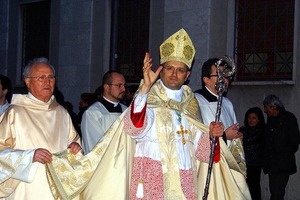The 6th century rule of life by Saint Benedict states that a monk (nun) vow stability, obedience and conversatio morum (fidelity to a monastic manner of life). A Benedictines’s “fidelity to a monastic manner of life” frequently spoken of as “conversion” instead of “fidelity,” so as to echo a centuries-long tradition of concept of conversio rather than conversatio. (Scholars have various opinions about the right word conveying what Benedict really meant and what was in the water at the time; conversatio means in our context monastic manner of life.)
Theologically for those who follow the Benedictine charism, conversatio means a person’s ongoing conversion to the Triune God lived in the monastic life which deepens virtue and extroverts grace. Conversatio, conversio, brings to mind that person seeks a return, a moral conversion, an upright moral life, an intense relationship with the Lord. The true conversatio is a recognizable sign of Christian maturity.
A sign of one’s maturity as a Christian is a life of generativity. That is, the adult Christian is going to be a witness to others of that particular union he or she has with the Trinity in a way that fruit is produced. The mature person does not live a life of reductions, but is filled with wonder and awe, and is willing to change even when it is difficult. Moreover, the mature Christian knows that he or she is not defined by the sins of youth, or the sins of the present. Grace in an a mature Christian, therefore, always is extroverted in some way.
The adult Christian comes his or her maturation in fidelity to the gospel, the sacraments, Church teaching and tradition, and mutual obedience by following (listening). The trouble is, most of us are asleep. We are converted when we can say with certitude that we are awake and that in Christ Jesus lives in me.
With outstretched hands the monk or nun sings the Suscipe (Psalm 118:116): Suscipe me, Domine, secundum eloquium tuum et vivam, et non confundas me ab expectatione mea. (Receive (or, sustain) me, O Lord, according to thy word and I shall live, let me not be disappointed in my hope.)
Today, a friend, Benedictine Sister Marie-Zita of the Heart of Jesus celebrated the 50th anniversary of professing her Benedictine vows as a nun of the Benedictines of Jesus Crucified. Her stability is lived at the Monastery of the Glorious Cross, Branford, CT. She gave thanks, we all gave thanks to God for a life of seeking the face of God in community. With hands held up in prayer Sister Zita stated her prayer to be sustained according to the Word.
Mass was offered by Dominican Father Jacob Restrick and the homily preached by Father Damien Schill with concelebrating priests Abbot Caedmon Holmes, OSB, of Portsmouth Abbey, Father David Borino, Father Robert Usenza and Father Gerry Masters. Deacon Sal assisted. About a 100 family and friends were in attendance.
I am grateful for the friendship I share with the nuns of this School of the Lord’s Service; I am elated that God has given Sister Zita the grace to mature in the monastic way of life.
Ut in omnibus glorificetur Deus.












